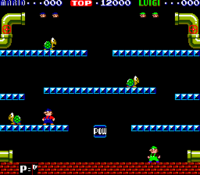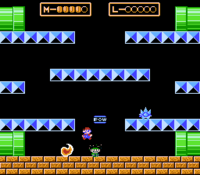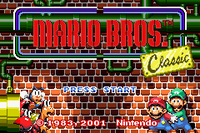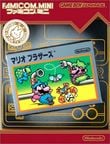Mario Bros. (game)
Template:Articleabout Template:Redirectshere Template:Infobox Mario Bros. is an arcade game made by Nintendo and released on July 14, 1983. It was also released on the NES under the Arcade Classics Series series of games (a version itself later ported to other systems), Atari 2600, Atari 5200, and Atari 7800 as well as a large multitude of home computer systems. The game introduces the first appearance of Luigi in a game, and is the first instalment in the Mario Bros. after the Game & Watch game of the same name. It is also included as a separate minigame, playing like the original game with updated graphics in the two-player mode of Super Mario Bros. 3 and for the role-playing game Mario & Luigi: Superstar Saga & all 4 games on the Super Mario Advance series on the Game Boy Advance.
Although Donkey Kong was the first official game to feature Mario, Mario Bros. is often considered the first "real" Mario game, as it is the first game to actually use Mario's name. Donkey Kong is also a part of the series of the same name.
Story
The story of this game revolves around two plumbers, Mario and Luigi, who are working in the sewers of New York[1]. The sewers are overrun by waves of enemies and the Mario Bros. have to defeat the enemies and get coins to receive their pay.
Gameplay
The game features a simple stage in which the player plays in an endless game. Much of the gameplay appears to have been inspired by an arcade game named Joust. Enemies come from the pipes on the top and head downwards, where they may enter the pipes again to return to the top. The goal in each phase is to defeat all enemies, which is done by jumping up and hitting the floor below enemies. This flips them, giving the player the chance to kick them away, which is rewarded with 800 points. The POW Block can also be used to flip enemies; however, it can be used only three times. After an enemy is knocked away, a coin (a "wafer" in the Atari 2600 version of the game[2]) appears from one of the pipes, and gives 800 points when collected. When all enemies are defeated, the player continues to the next phase. In later levels, different types of enemies and harming fireballs appear. From time to time, a bonus level appears where all coins have to be collected in order to get an extra 3000-5000 points. The POW Block regenerates after the second bonus level and every subsequent bonus level.
Characters
Playable
- Mario (Player 1) / Red Mario with blue overalls. (Player 1 in Super Mario Advance/Superstar Saga remake.)
- Luigi (Player 2) / Green Mario with purple overalls. (Player 2 in Super Mario Advance/Superstar Saga remake.)
- Yellow Mario with white overalls. (Player 3 in Super Mario Advance/Superstar Saga remake.)
- Blue Mario with yellow overalls. (Player 4 in Super Mario Advance/Superstar Saga remake.)
Enemies
Target enemies must be defeated to clear the phase while other enemies should be defeated by the player's discretion. Each phase consists of one or two types of targets with a maximum of six targets. Shellcreepers and Sidesteppers appear together only in Phase 5 (6 in Japan). The last target enemy will always move at its fastest pace unless said enemy is a Fighter Fly.
Target enemies
- Shellcreeper - The first enemies in the game, a possible relation to Koopas. They are replaced by Spinies in remade versions.
- Sidestepper - Crab creatures that are harder to defeat and have appeared in various games. They first appear in Phase 4 (5 in Japan).
- Fighter Fly - Flies that jump up and down. They first appear in Phase 6 (7 in Japan).
Other enemies
- Slipice - Ice creatures that appear in a lot of games. They have been renamed Freezie, and first appear in Phase 9 (10 in Japan). When one self-destructs, it covers its platform in ice, hence the name.
- Icicle - They first appear in phase 16 (17 in Japan) and attack by dropping from the ceiling.
- Fireball - Red ones bounce diagonally around the stage while Green ones travel horizontally. They can be defeated by bashing them from underneath, just as they hit the ground. The player can also use a POW Block to defeat them as well. The sprites for green fireballs are swapped with Boos in the Super Mario All-Stars version's Battle Game but not for the in-game 2 player mode where both types appear red.
Remake exclusives
- Koopa Troopa (Super Mario All-Stars)
- Spiny (Super Mario Bros. 3, Super Mario Advance series and Mario & Luigi: Superstar Saga)
- Boo (Super Mario All-Stars)
- Bowser (Super Mario Advance series and Mario & Luigi: Superstar Saga)
Reception
The game has received mostly positive reviews. IGN rated the game 91st in their Top 100 NES Games list [3].
Remakes and ports
Classic Series
In 1993, Nintendo released a European-exclusive version of the game called the Classic Series version. This version was perhaps the closest port of the arcade game, and was one of only two ports to have intermissions (the other being the Atari XE version). It was based on Kaettekita Mario Bros., and retained all the arcade features from it, plus being able to change direction in mid-air.
Super Mario Bros. 3
Mario Bros. is included as a separate minigame, called "Battle Mode", in Super Mario Bros. 3 for the NES and as part of the SMB3 port included in Super Mario All-Stars, utilising SMB3 physics and a variation on its graphics. This was the first version where Spinies replaced Shellcreepers, making it more obvious not to jump on the enemy, which would become standard in later remakes to avoid confusion with the ubiquitous Koopa Troopas of later games.
It includes two bonus levels - a fountain that sprays out coins, and a series of kickable ? Blocks.
A battle can also be entered in two-player mode in the main game, by the active player on the map opening the Ⓜ or Ⓛ that represents the inactive player. This allows the players to fight over the "cards", obtained by finishing a normal level, that give one to five extra lives when three are collected.
Game Boy Advance remakes
A remake of Mario Bros. is included in every Super Mario Advance game, as well as the RPG Mario and Luigi: Superstar Saga. All of these games can connect to each other to play Classic or Battle mode with up to four players. Classic is based on the co-op mode from the original. Battle is based on the Battle Game from Super Mario All-Stars. The remake also uses the GBA's Single-Pak multiplayer feature. It can connect and play with other GBA systems without the game, although Battle is the only multiplayer mode that can be played in this way.
The GBA remake of Mario Bros. enhances the graphics to take advantage of the GBA's 32-bit capabilities, including adding backgrounds to the stages. Music is added where it was originally absent, and voice clips are added in single-player mode. Jumping onto platforms has been made easier; mid-air turning is allowed, as opposed to the original where Mario or Luigi had to stay in one direction during jumping. The POW Block resets every few stages, and two such blocks appear now as opposed to just one. The Power Squat Jump from Super Mario Bros. 2 (US version) has been added, and the Bonus Stages are now noticeably easier than they were originally.
Ports of NES version
Several direct ports of the NES version, running under emulation, have been released on later consoles. First was Mario Bros.-e, a game for the e-Reader, released on November 11, 2002 in the United States only, which omitted the two-player support. Japan next got an exclusive release in the Famicom Mini series for Game Boy Advance, unconnected with the remade version described above, on May 21, 2004.
It was also re-released on Virtual Console for Wii for 500 Wii Points in November/December 2006, and for 3DS on 8 May 2013 (Japan), 9 Jan 2014 (Euro/Aus) and 30 Jan 2014 (NA, US$4.99). It has also been released on the Wii U for the same price.
The NES and Famicom version is also one of the 30 titles included in the NES Classic Edition and Nintendo Classic Mini: Family Computer, respectively.
Luigi Bros.
An emulation of the game known as Luigi Bros. is included in Super Mario 3D World as unlockable content, with the only difference being that Mario is replaced by Luigi in his current appearance (green hat and shirt with blue overalls); player 2's Luigi retains his original appearance (white hat and shirt with green overalls, similar to Fire Luigi's color scheme in later Mario games). If the player has save data of New Super Luigi U, Luigi Bros. can be played straight away without having to be unlocked. Unlike Super Mario 3D World itself, which is usually played using a 16:9 "Widescreen" aspect ratio, Luigi Bros. uses a 4:3 aspect ratio, obviously due to the original Mario Bros. NES game using it. Luigi Bros. is unlocked by defeating Meowser in The Great Tower Of Bowser Land in World Bowser.
Sequels
The game had three obscure sequels: two direct 1984 follow-ups for Japanese home computers called Punch Ball Mario Bros. & Mario Bros. Special, and a 1995 entry for the Virtual Boy called Mario Clash.
References in later games
- Super Mario Bros. 3: The "Battle Mode" is very similar to Mario Bros.'s gameplay.
- Super Smash Bros.: Mario's green recolor resembles the colors Luigi wears in the Japanese artwork of the game.
- Mario & Luigi: Superstar Saga: A Mario Bros.-themed level appears in this game. A version of the game itself (as in the Advance ports) is also included besides having the flyfighter as enemy.
- Mario Power Tennis: A court is named after the game, and features many elements from it, such as Shellcreepers, POW Blocks and even similar music.
- Dance Dance Revolution: Mario Mix: The "Underground Mozart" music is based on the first "Stage Start" theme
- WarioWare: Twisted!: A microgame based on this game appears in 9-Volt's stage.
- Super Smash Bros. Brawl: There is a stage based on the first stages of the game, as well as a remixed version of the title's music.
- Super Paper Mario: Super Dimentio indirectly alludes to the Shellcreepers' weakness during the final battle, when taunting Mario and his party that they shall "wallow in helplessness like upside-down turtles!"
- Mario's Time Machine: The NES version of this game features a stage similar to the sewers from Mario Bros.
- WarioWare: D.I.Y. Showcase: A microgame based on this game appears in 18-Volt's stage.
- New Super Mario Bros. Wii: One of the underground coin battle areas resemble the Mario Bros. arena.
- New Super Mario Bros. 2: Round 1 was remade as part of the Gold Classics Pack, a downloadable course pack. Additionally, White Raccoon Mario looks similar to Player 3.
- New Super Mario Bros. U: The second Coin Battle stage overall resembles Mario Bros.'s arenas.
- Super Mario 3D World: Luigi Bros., a port starring Luigi instead of Mario, appears in this game. It is unlocked after the player completes The Great Tower of Bowser Land level. Alternatively, if the player has save data for New Super Luigi U on their Wii U, Luigi Bros. is available from the start of the game.
- Super Smash Bros. for Nintendo 3DS / Wii U: Mario's blue recolor resembles the colors Mario wears in the Japanese artwork of the game.
- Super Mario Maker: Four of the forms Costume Mario takes on are based on this game. The costumes for Mario, Shellcreeper and Sidestepper are earned as random rewards in 100 Mario Challenge's Expert mode, while the Fighter Fly costume is unlocked upon clearing a harder version of the Gnat Attack minigame.
Staff
- Main article: List of Mario Bros. staff
The Arcade and NES versions were directed by Hiroshi Yamauchi, both versions were designed by Shigeru Miyamoto. The music of both versions was composed by Yukio Kaneoka. However the Commodore 64 version music was composed by Fred Gray.
Gallery
- Mario MB.png
- Luigi Mario Bros.png
- Sidestepper - Mario Bros.png
- MarioBros7.png
Screenshot of Phase 1
- Sewer MB.png
Typical play
- MarioBrosCabinet.jpg
Arcade cabinet.
- MarioBrosMario.gif
Sprite of Mario
- MarioBrosCoin.gif
Names in other languages
Trivia
- Phase 2 was removed for non-Japanese versions of the game.
- The music that plays when the player begins Phase 1 is Mozart's Eine kleine Nachtmusik, which is also featured in Dance Dance Revolution: Mario Mix and Super Smash Bros. Brawl.
- Three months before this game was released to arcades, a game called "Mario Bros." was released as a Game & Watch. Beyond featuring Mario & Luigi, it bears no similarity to this game.
- Mario's outfit on the Japanese cover would later be used as an alternate costume for Mario in Super Smash Bros for Nintendo 3DS / Wii U and an alternate costume for Wario in Super Smash Bros. Brawl and Super Smash Bros. for Nintendo 3DS / Wii U. The outfit also made a cameo during Mario's transformation into a Super Mario in the DIC cartoons. Additionally, Luigi's outfit on the Japanese cover would later be used as an alternate costume for Mario in the Super Smash Bros. series and an alternate costume for Wario in Super Smash Bros. Brawl and Super Smash Bros. for Nintendo 3DS / Wii U.
References
- ^ "Exclusive Interview With Nintendo Gaming Mastermind Shigeru Miyamoto". Popular Mechanics. October 19, 2009. Retrieved 25 November 2009.
- ^ Mario Bros. Atari instruction booklet, page 2.
- ^ [1]
| Mario Bros. | |
|---|---|
| Characters | Mario • Luigi |
| Items and objects | ? Blockb • ? Kinokoc • Cardb • Coin • Eggd • Fish Skeletond • Floor • Garbage cand • Heartd • Koopa Shelld • Ladderb • POW Block • Starmand • Super Mushroomc • Wafera |
| Enemies | Booc • Bowserd • Fighter Fly • Fireball • Icicle • Koopac • Shellcreeper • Sidestepper • Slipice • Spinybcd |
| Other | Gallery • Staff |




